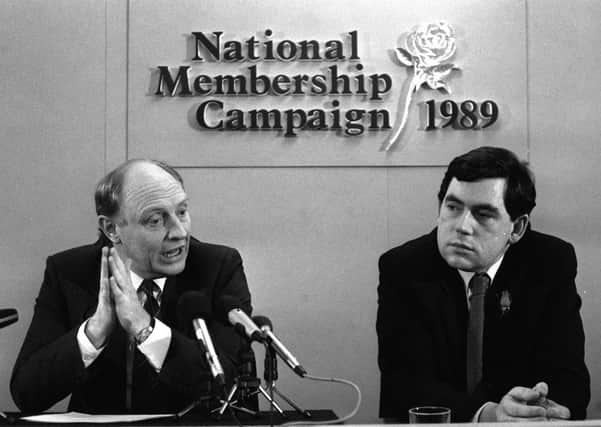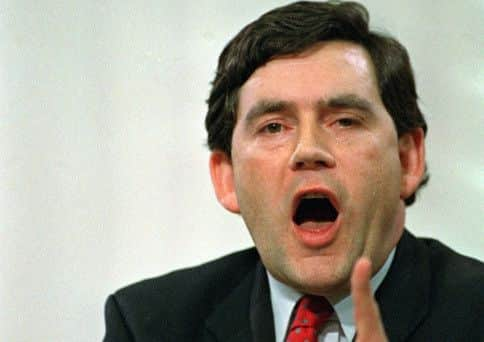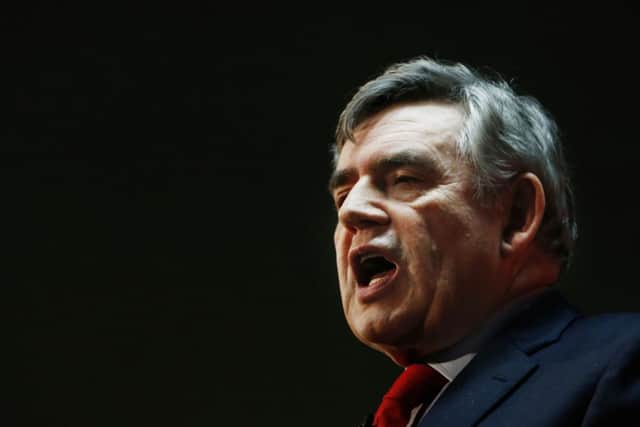Gordon Brown so stand down as MP: How will history remember him?


It is understood that the 63-year-old will announce in a speech in his Kirkcaldy constituency tonight that he will step down at the general election in May, after playing a key role in the Scottish independence referendum campaign this year.
The Labour MP has focused on charity work and his role as United Nations special envoy for global education since his resignation as prime minister in 2010.
Advertisement
Hide AdAdvertisement
Hide AdMr Brown was first elected to Parliament in 1983, was chancellor from 1997 to 2007 and then prime minister from 2007 to 2010.


His last-minute intervention in the referendum debate was widely credited with helping the pro-union Better Together campaign to victory.
A timetable he championed for devolving more powers to Scotland was later endorsed by the three UK party leaders in their vow for greater autonomy for the Scottish Parliament in the event of a No vote.
A series of impassioned speeches, culminating in an eve-of-poll rallying cry in Glasgow, was also widely praised.
Advertisement
Hide AdAdvertisement
Hide AdMr Brown had been tipped to stand for the Scottish Labour leadership following the shock resignation of Johann Lamont, but instead made clear he had no intention of returning to frontline politics.


He won the Kirkcaldy and Cowdenbeath seat with a majority of more than 23,000 in the last election.
Former Labour chancellor Alistair Darling has also announced that he is to stand down as an MP at the next general election in the wake of the referendum.
GORDON BROWN became prime minister without an election in 2007 with the departure of Tony Blair shortly after winning an historic third term for Labour.
Advertisement
Hide AdAdvertisement
Hide AdWinning a fourth term for Labour was always going to be a tall order after a deep recession, two unpopular wars and a huge parliamentary expenses scandal, but throughout the election campaign Mr Brown insisted he was fighting for a majority Labour government.
Even polls which gave Conservatives the lead during the campaign held out the hope for Mr Brown that he might be thrown a lifeline by the peculiarities of the Westminster voting system which ultimately produced the current Tory-Liberal Democrat coalition.
The 63-year-old Scot has often said he would be ready to move on to work in charity or education if he felt he had nothing more to offer Labour, and now it seems he is ready to adopt such a change in career.
Born the son of a Church of Scotland minister in 1951, Mr Brown was fast-tracked into Edinburgh University aged just 16. There, he suffered a rugby accident which blinded him in one eye and he required lengthy treatment to save the sight in the other.
Advertisement
Hide AdAdvertisement
Hide AdWhile working as a politics lecturer and journalist, he fought his way into a prominent position in the Scottish Labour Party, arriving at Westminster in 1983 as MP for Dunfermline East.
He was swiftly spotted as a rising talent, joining the front benches within two years and rising to shadow chancellor in 1992.
After the surprise death of John Smith in 1994, he was viewed by many as a natural successor. But he struck a deal with Tony Blair, under which the more presentationally-talented younger man would take the leadership in return for a promise of control over economic policy and an eventual handover of power.
Together, the two men forged the New Labour machine which triumphed in 1997 and dominated UK politics for the following decade.
Advertisement
Hide AdAdvertisement
Hide AdBut the deal carried in it the seeds of their future rivalry, with apparently reliable reports of furious rows behind the scenes in Downing Street as Mr Brown demanded Mr Blair name a date for the succession.
Meanwhile, Mr Brown married PR executive Sarah Macaulay at the age of 49. The couple faced heartache in their family life, as first child Jennifer died after just 10 days in 2002 and second son Fraser was diagnosed with cystic fibrosis.
After 10 years at the Treasury, where he earned a reputation as the “Iron Chancellor” who claimed to have ended boom and bust, Mr Brown finally replaced Mr Blair at 10 Downing Street on June 27, 2007.
Supporters hailed him as the “big clunking fist” who would crush any opposition at the despatch box, but Tories demanded an instant election for the unelected PM to seek a mandate.
Advertisement
Hide AdAdvertisement
Hide AdMr Brown did indeed toy with the idea of a snap election amid favourable polls, but his decision to dump the idea after a Tory revival, fuelled by promises to slash inheritance tax, led to him being branded a “ditherer” and a slump in the polls to levels last seen under Michael Foot’s disastrous leadership.
Electoral conditions were never again so favourable for Labour. As storm clouds gathered over the economy and the Government was forced into multibillion-pound bank bailouts, Mr Brown’s hard-won reputation for economic competence came under near-unsustainable pressure.
And the expenses scandal cast a pall over his premiership, even if he did not personally face serious charges.
Opponents revived the claim by an anonymous Labour insider that Mr Brown was “psychologically flawed”, while critics in the blogosphere mocked him for his awkward smile and his hapless attempts to get to grips with modern technology like the internet.
Advertisement
Hide AdAdvertisement
Hide AdDespite setbacks which would have shaken a less determined man, Mr Brown showed no sign of giving in. He led international agreement at the London Summit to tackle the downturn and cemented a surprising new alliance with former enemy Peter Mandelson to see off a series of leadership challenges.
Meanwhile, wife Sarah was brought into the public eye to show the softer side of a politician who has always seemed uncomfortable talking about his personal life.
But his public relations drive crashed during the 2010 election campaign when he was caught on microphone describing a voter he had just spoken to in Rochdale as a “bigoted woman”.
Gillian Duffy, 65, had challenged Mr Brown on a number of issues including immigration and crime.
Advertisement
Hide AdAdvertisement
Hide AdAfter conceding defeat in the 2010 general election he appeared destined for a quiet life on the backbenches of Westminster alongside his charitable projects.
He remained an MP for Kirkcaldy and Cowdenbeath but his appearances in the House of Commons were occasional - so much so that they attracted a few more onlookers at traditionally quieter times in Parliament.
But as the referendum campaign neared its climax, Mr Brown emerged from the shadows to play an increasingly prominent role in the No camp.
He announced a new fast-track timetable for further devolution to Scotland, pledging that work would begin the day after the referendum in the event of a No vote.
Advertisement
Hide AdAdvertisement
Hide AdThe former prime minister received widespread praise from fellow No campaigners, including those considered political opponents, as he pleaded with undecided voters to reject the “risks” of independence.
But as unionist joy turned to despair for Labour after the No vote with a nosedive in the polls and the bitter departure of Scottish leader Johann Lamont, Mr Brown batted away frequent calls for him to stand as Scottish Labour leader to steady the ship.
While his political life will shortly be at an end, the polarising tags of Blairite and Brownite will continue to echo through the Labour Party.